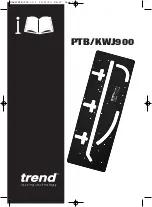
16
| English
2
6
0
9
007 1
26
| (1
2
.4.13)
Bosch Power Tools
Selecting the Sanding Sheet
Depending on the
m
aterial to be worked and the required rate of
m
aterial re
m
oval, different sanding sheets are available:
Dust/Chip Extraction
Dusts fro
m
m
aterials such as lead-containing coatings,
so
m
e wood types,
m
inerals and
m
etal can be har
m
ful to
one’s health. Touching or breathing-in the dusts can cause
allergic reactions and/or lead to respiratory infections of
the user or bystanders.
Certain dusts, such as oak or beech dust, are considered
as carcinogenic, especially in connection with wood-treat-
m
ent additives (chro
m
ate, wood preservative). Materials
containing asbestos
m
ay only be worked by specialists.
– As far as possible, use a dust extraction syste
m
suitable
for the
m
aterial.
– Provide for good ventilation of the working place.
– It is reco
mm
ended to wear a P
2
filter-class respirator.
Observe the relevant regulations in your country for the
m
aterials to be worked.
Prevent dust accumulation at the workplace.
Dusts can
easily ignite.
Connecting the Dust Extraction (see figure A)
The dust extraction
16
is intended only when working with the
sanding plate
9
; it is not of use in co
m
bination with other ap-
plication tools.
For sanding, always connect the dust extraction.
To
m
ount the dust extraction
16
(accessory), re
m
ove the ap-
plication tool and the depth stop
11
.
S
lide the dust extraction
16
over and beyond the tool holder
5
to the stop onto the gear head of the power tool. Insert fas-
tening screw
15
into the corresponding recess on the hous-
ing. To lock the screw, turn it to the position.
Pay attention that the felt ring
17
is unda
m
aged and faces
tightly against the sanding plate
9
. Replace a da
m
age felt ring
i
mm
ediately.
Place a vacuu
m
hose
13
(accessory) onto the vacuu
m
con-
nection
14
. Connect the vacuu
m
hose
13
with a vacuu
m
cleaner (accessory).
An overview for connecting to various vacuu
m
cleaners can be
found on the graphics page.
The vacuu
m
cleaner
m
ust be suitable for the
m
aterial being
worked.
When vacuu
m
ing dry dust that is especially detri
m
ental to
health or carcinogenic, use a special vacuu
m
cleaner.
To re
m
ove the dust extraction
16
, turn fastening screw
15
to
the
position and pull the dust extraction fro
m
the gear
head of the power tool.
Operation
Starting Operation
Observe the mains voltage!
The voltage of the power
source
m
ust correspond with the data on the type plate of
the
m
achine.
Switching On and Off
To
start
the
m
achine, push the On/Off switch
1
forward so
that the
“I”
is indicated on the switch.
To
switch off
the
m
achine, push the On/Off switch
1
toward
the rear so that the
“0”
is indicated on the switch.
To save energy, only switch the power tool on when using it.
Preselecting the Orbital Stroke Rate
With the thu
m
bwheel for preselection of the orbital stroke
rate
2
, you can preselect the required orbital stroke rate, even
during operation.
The required stroke rate depends on the
m
aterial and the
working conditions and can be deter
m
ined through practical
testing.
When sawing, cutting and sanding harder
m
aterials, e.g.,
wood or
m
etal, it is reco
mm
ended to work with orbital stroke
rate “
6
”; for softer
m
aterials, such as plastic, orbital stroke
rate “4” is reco
mm
ended.
Sanding disc
Material
Application
Grain size
Red quality
– All wooden
m
aterials
(e.g., hardwood, soft-
wood, chipboard, build-
ing board)
– Metal
m
aterials
For coarse-sanding, e.g. of rough, unplaned bea
m
s and
boards
coarse
40
6
0
For face sanding and planing s
m
all irregularities
m
ediu
m
80
100
1
2
0
For finish and fine sanding of wood
fine
180
2
40
3
2
0
400
White quality
– Paint
– Varnish
– Filling co
m
pound
– Filler
For sanding off paint
coarse
40
6
0
For sanding pri
m
er (e.g., for re
m
oving brush dashes,
drops of paint and paint run)
m
ediu
m
80
100
1
2
0
For final sanding of pri
m
ers before coating
fine
180
2
40
3
2
0
OBJ_BUCH-345-009.book Page 16 Friday, April 12, 2013 11:38 AM















































